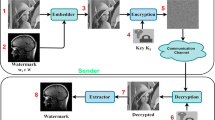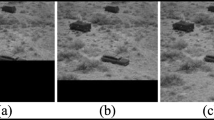Abstract
The simple least-significant-bit (LSB) substitution technique is the easiest way to embed secret data in the host image. To avoid image degradation of the simple LSB substitution technique, Wang et al. proposed a method using the substitution table to process image hiding. Later, Thien and Lin employed the modulus function to solve the same problem. In this paper, the proposed scheme combines the modulus function and the optimal substitution table to improve the quality of the stego-image. Experimental results show that our method can achieve better quality of the stego-image than Thien and Lin’s method does.
Similar content being viewed by others
References
D. W. Bender, N. M. Gruhl, and A. Lu, “Techniques for Data Hiding,” IBM Syst. J. 35, 313–336 (1996).
C. C. Chang and C. S. Chan, “A Watermarking Scheme Based on Principal Component Analysis Technique,” Informatica 14(4), 1–13 (2003).
C. C. Chang, J. Y. Hsiao and C. S. Chan, “Finding Optimal LSB Substitution in Image Hiding by Dynamic Programming Strategy,” Pattern Recognit. 36(7), 1583–1595 (July, 2003).
L. H. Chen and J. J. Lin, “Mean Quantization Based Image Watermarking,” Image and Vision Computing 21(8), 717–727 (August, 2003).
Y. H. Chu and S. Chang, “Dynamical Cryptography Based on Synchronized Chaotic Systems,” Electron. Lett. 35(12), 974–975 (1999).
W. D. Chun and T. E. Hsiang, “Data Hiding in Images via Multiple-Based Number Conversion and Lossy Compression,” IEEE Trans. Consumer Electron. 44(4), 1406–1412 (1998).
H. J. Highland, “Data Encryption: a Non-mathematical Approach,” Computer Security 16, 369–386 (1997).
M. S. Hwang, C. C. Chang, and K. F. Hwang, “A Water-marking Technique Based on One-Way Hash Functions,” IEEE Trans. Consumer Electron. 45(2), 286–294 (1999).
S. D. Lin and C. F. Chen, “A Robust DCT-Based Water-marking for Copyright Protection,” IEEE Trans. Consumer Electron. 46(3), 415–421 (2000).
C. C. Thien and J. C. Lin, “A Simple and High-Hiding Capacity Method for Hiding Digit-by-Digit Data in Images Based on Modulus Function,” Pattern Recognit. 36(12), 2875–2881 (December, 2003).
C. S. Tsai, C. C. Chang, and T. S. Chen, “Sharing Multiple Secrets in Digital Images,” J. Syst. Software 64(2), 163–170 (November, 2002).
R. Z. Wang, C. F. Lin, and J. C. Lin “Image Hiding by Optimal LSB Substitution and Genetic Algorithm,” Pattern Recognit. 34(3), 671–683 (March, 2001).
D. C. Wu and W. H. Tsai, “A Steganographic Method for Images by Pixel-Value Differencing,” Pattern Recognit. Lett. 24(9–10), 1613–1626 (June, 2003).
Author information
Authors and Affiliations
Additional information
The text was submitted by the authors in English.
Chin-Shiang Chan received his BS degree in Computer Science in 1999 from the National Cheng Chi University, Taipei, Taiwan and the MS degree in Computer Science and Information Engineering in 2001 from the National Chung Cheng University, ChiaYi, Taiwan. He is currently a Ph.D. student in Computer Science and Information Engineering at the National Chung Cheng University, Chiayi, Taiwan. His research fields are image hiding and image compression.
Chin-Chen Chang received his BS degree in applied mathematics in 1977 and his MS degree in computer and decision sciences in 1979, both from the National Tsing Hua University, Hsinchu, Taiwan. He received his Ph.D. in computer engineering in 1982 from the National Chiao Tung University, Hsinchu, Taiwan. During the academic years of 1980–1983, he was on the faculty of the Department of Computer Engineering at the National Chiao Tung University. From 1983–1989, he was on the faculty of the Institute of Applied Mathematics, National Chung Hsing University, Taichung, Taiwan. From 1989 to 2004, he has worked as a professor in the Institute of Computer Science and Information Engineering at National Chung Cheng University, Chiayi, Taiwan. Since 2005, he has worked as a professor in the Department of Information Engineering and Computer Science at Feng Chia University, Taichung, Taiwan. Dr. Chang is a Fellow of IEEE, a Fellow of IEE and a member of the Chinese Language Computer Society, the Chinese Institute of Engineers of the Republic of China, and the Phi Tau Phi Society of the Republic of China. His research interests include computer cryptography, data engineering, and image compression.
Yu-Chen Hu received his Ph.D. degree in Computer Science and Information Engineering from the Department of Computer Science and Information Engineering, National Chung Cheng University, Chiayi, Taiwan in 1999. Dr. Hu is currently an assistant professor in the Department of Computer Science and Information Engineering, Providence University, Sha-Lu, Taiwan. He is a member of the SPIE society and a member of the IEEE society. He is also a member of the Phi Tau Phi Society of the Republic of China. His research interests include image and data compression, information hiding, and image processing.
Rights and permissions
About this article
Cite this article
Chan, C.S., Chang, C.C. & Hu, Y.C. Image hiding scheme using modulus function and optimal substitution table. Pattern Recognit. Image Anal. 16, 208–217 (2006). https://doi.org/10.1134/S1054661806020076
Received:
Issue Date:
DOI: https://doi.org/10.1134/S1054661806020076




